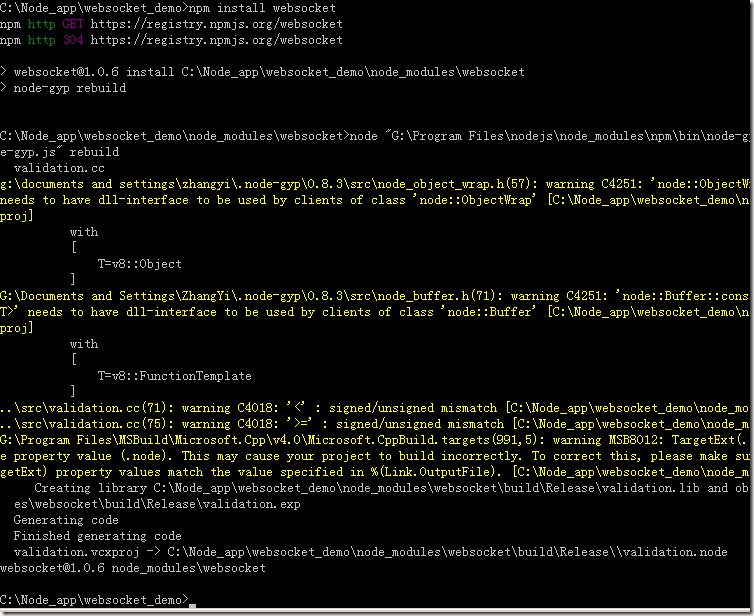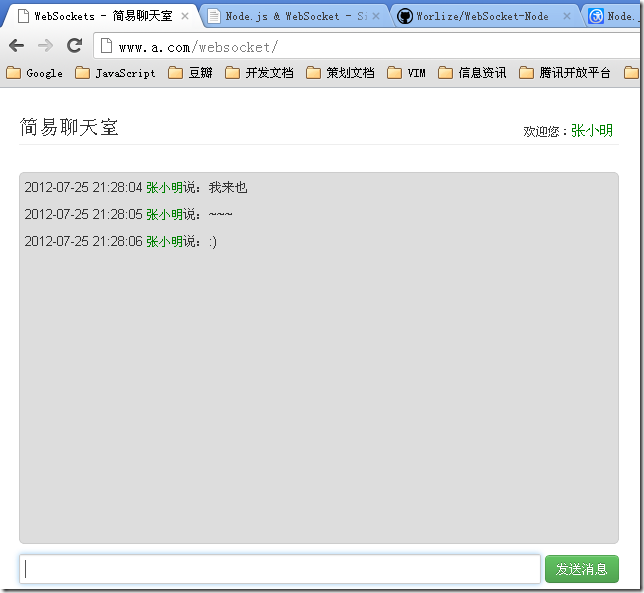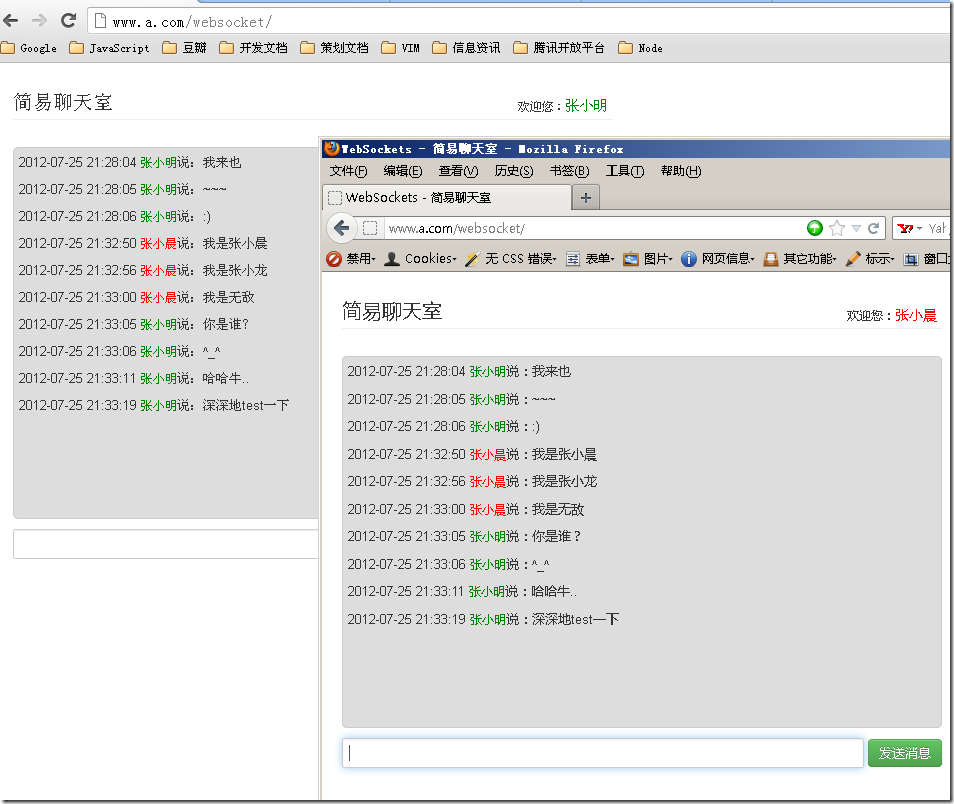本实例程序在Windows下测试通过。
上述实例支持以下浏览器:
Firefox 7-9 (Old) (Protocol Version 8)
Firefox 10+ (Protocol Version 13)
Chrome 14,15 (Old) (Protocol Version 8)
Chrome 16+ (Protocol Version 13)
Internet Explorer 10 (Preview) (Protocol Version 13)
消息的传递也比较简单,Client –> Server, Server –> Client

服务器广播消息

数据传输使用的是JSON格式,前台建立连接的代码比较简单,ex:
1: $(function () {
2: window.WebSocket = window.WebSocket || window.MozWebSocket;
3:
4: var connection = new WebSocket('ws://127.0.0.1:1337');
5:
6: connection.onopen = function () {
7: //已建立连接
8: };
9:
10: connection.onerror = function (error) {
11: //接收或发送消息时遇到了错误
12: };
13:
14: connection.onmessage = function (message) {
15:
16: try {
17: var json = JSON.parse(message.data);
18: } catch (e) {
19: console.log('不能被正常解析的数据:', message.data);
20: return;
21: }
22:
23: // todo
24: };
25: });
后端的实现,直接使用别人写好的模块所以传统比较简单一点(想在Windows下运行chat-server还是有点麻烦的),因为该模块在Windows下安装时,需要Microsoft Visual C++和Python 2.7的支持。--如果没有安装这两个东东,还得先安装一下。
如果顺利的话,会看到如下图所示的界面:

这样我们就可以创建Server了,实现的代码也并不复杂:
1: var WebSocketServer = require('websocket').server;
2: var http = require('http');
3:
4: var server = http.createServer(function(request, response) {
5: console.log((new Date()) + ' Received request for ' + request.url);
6: response.writeHead(404);
7: response.end();
8: });
9: server.listen(8080, function() {
10: console.log((new Date()) + ' Server is listening on port 8080');
11: });
12:
13: wsServer = new WebSocketServer({
14: httpServer: server,
15: // You should not use autoAcceptConnections for production
16: // applications, as it defeats all standard cross-origin protection
17: // facilities built into the protocol and the browser. You should
18: // *always* verify the connection's origin and decide whether or not
19: // to accept it.
20: autoAcceptConnections: false
21: });
22:
23: function originIsAllowed(origin) {
24: // put logic here to detect whether the specified origin is allowed.
25: return true;
26: }
27:
28: wsServer.on('request', function(request) {
29: if (!originIsAllowed(request.origin)) {
30: // Make sure we only accept requests from an allowed origin
31: request.reject();
32: console.log((new Date()) + ' Connection from origin ' + request.origin + ' rejected.');
33: return;
34: }
35:
36: var connection = request.accept('echo-protocol', request.origin);
37: console.log((new Date()) + ' Connection accepted.');
38: connection.on('message', function(message) {
39: if (message.type === 'utf8') {
40: console.log('Received Message: ' + message.utf8Data);
41: connection.sendUTF(message.utf8Data);
42: }
43: else if (message.type === 'binary') {
44: console.log('Received Binary Message of ' + message.binaryData.length + ' bytes');
45: connection.sendBytes(message.binaryData);
46: }
47: });
48: connection.on('close', function(reasonCode, description) {
49: console.log((new Date()) + ' Peer ' + connection.remoteAddress + ' disconnected.');
50: });
51: });
从上述的例子中可以看出,websocket支持两种传递方式:二进制流、utf8的文本流。前面的例子中所使用的是utf8文本流
完整的chat-server.js的代码如下:
1: // http://ejohn.org/blog/ecmascript-5-strict-mode-json-and-more/
2: "use strict";
3:
4: // Optional. You will see this name in eg. 'ps' or 'top' command
5: process.title = 'node-chat';
6:
7: //websocket服务器监听的端口
8: var webSocketsServerPort = 1337;
9:
10: var webSocketServer = require('websocket').server;
11: var http = require('http');
12:
13: //保存最近100条消息记录
14: var history = [ ];
15:
16: //当前连接的客户端
17: var clients = [ ];
18:
19: /**
20: * 对聊天内容进行字符转义
21: */
22: function htmlEntities(str) {
23: return String(str).replace(/&/g, '&').replace(/</g, '<').replace(/>/g, '>').replace(/"/g, '"');
24: }
25:
26:
27: var colors = [ 'red', 'green', 'blue', 'magenta', 'purple', 'plum', 'orange' ];
28: colors.sort(function(a,b) { return Math.random() > 0.5; } );
29:
30: /**
31: * HTTP server
32: */
33: var server = http.createServer(function(request, response) {});
34:
35: server.listen(webSocketsServerPort, function() {
36: console.log(getNow() + " WebSocket Server is listening on port:" + webSocketsServerPort);
37: });
38:
39: /**
40: * WebSocket server
41: * WebSocket server is tied to a HTTP server. To be honest I don't understand why.
42: */
43: var wsServer = new webSocketServer({
44: httpServer: server
45: });
46:
47: //每一个客户端请求建立连接时,都将触发此方法
48: wsServer.on('request', function(request) {
49:
50: console.log(getNow() + ' ' + request.origin + ' 请求连接.');
51:
52: // accept connection - you should check 'request.origin' to make sure that client is connecting from your website
53: // (http://en.wikipedia.org/wiki/Same_origin_policy)
54: var connection = request.accept(null, request.origin);
55:
56: //保存当前请求连接客户端的索引,以方便在断开连接时,从连接池中移除该连接
57: var index = clients.push(connection) - 1;
58: var userName;
59: var userColor;
60:
61: console.log(getNow() + ' 已建立连接...');
62:
63: //推送历史聊天记录
64: if (history.length > 0) {
65: connection.sendUTF(JSON.stringify({type: 'history', data: history}));
66: }
67:
68: //某一客户端发送消息过来
69: connection.on('message', function(message) {
70: if (message.type === 'utf8') {
71:
72: //第一次请求用于保存用户信息
73: if (!userName) {
74: userName = htmlEntities(message.utf8Data);
75:
76: userColor = colors.shift();
77: connection.sendUTF(JSON.stringify({ type:'color', data: userColor }));
78: console.log(getNow() + ' 用户已登录: ' + userName + ' -- ' + userColor);
79:
80: } else {
81: //记录消息并广播
82: console.log(getNow() + userName + '-说: ' + message.utf8Data);
83:
84: //传递给客户端的数据格式
85: var obj = {
86: time: (new Date()).getTime(),
87: text: htmlEntities(message.utf8Data),
88: author: userName,
89: color: userColor
90: };
91: history.push(obj);
92:
93: //取数组最后100条消息记录并保存
94: history = history.slice(-100);
95:
96: //将消息广播给所有客户端
97: var json = JSON.stringify({ type:'message', data: obj });
98: for (var i=0; i < clients.length; i++) {
99: clients[i].sendUTF(json);
100: }
101:
102: console.log("总的客户端连接数:" + clients.length);
103: }
104: }
105: });
106:
107: //用户断开连接
108: connection.on('close', function(connection) {
109: if (!userName && !userColor) {
110: console.log(getNow() + " -- " + connection.remoteAddress + " 断开链接.");
111:
112: //从连接池中移除连接
113: clients.splice(index, 1);
114:
115: //回收访用户所使用的颜色
116: colors.push(userColor);
117: }
118: });
119:
120: });
121:
122: function getNow() {
123: return new Date().format('yyyy-MM-dd hh:mm:ss');
124: }
125:
126: Date.prototype.format = function (fmt) { //author: meizz
127: var o = {
128: "M+": this.getMonth() + 1,
129: "d+": this.getDate(),
130: "h+": this.getHours(),
131: "m+": this.getMinutes(),
132: "s+": this.getSeconds(),
133: "q+": Math.floor((this.getMonth() + 3) / 3),
134: "S": this.getMilliseconds()
135: };
136: if (/(y+)/.test(fmt)) fmt = fmt.replace(RegExp.$1, (this.getFullYear() + "").substr(4 - RegExp.$1.length));
137: for (var k in o)
138: if (new RegExp("(" + k + ")").test(fmt)) fmt = fmt.replace(RegExp.$1, (RegExp.$1.length == 1) ? (o[k]) : (("00" + o[k]).substr(("" + o[k]).length)));
139: return fmt;
140: }
运行supervisor chat-server.js或者node chat-server.js 就OK了~


使用Firefox测试一下:)

本文参考: